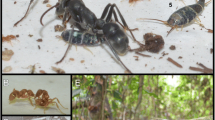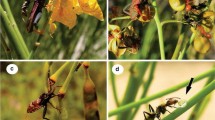Abstract
Individual ants of Aphaenogaster carolinensis Wheeler were placed in two way combinations with four sympatric ant species (Aphaenogaster lamellidens Mayr, Crematogaster lineolata Say, Pachycondyla chinensis Emery and Prenolepis imparis Say) to determine whether their interspecific behavior was dependent upon the ant species they were confronted with. The tendency of A. carolinensis to initiate and terminate interactions, and the durations of those interactions, were measured for all combinations. There was no significant effect of species on initiation or termination. There was a significant effect of species on the duration of interactions that were both initiated and terminated by A. carolinensis. Durations of interactions with A. lamellidens were significantly longer than with other species. The conclusion is that the interspecific behavior of A. carolinensis is dependent in part on the species it is interacting with.


Similar content being viewed by others
References
Carpintero S, Retana J, Cerdá X, Reyes-López J, Arias de Reyna L (2007) Exploitative strategies of the invasive Argentine ant (Linepithema humile) and native ant species in a southern Spanish pine forest. Environ Entomol 36:1100–1111
Cole AC Jr (1940) A guide to the ants of the Great Smoky Mountains National Park, Tennessee. Am Midl Nat 24:1–88
Fellers JH (1987) Interference and exploitation in a guild of woodland ants. Ecology 68:1466–1478
Gibbons L, Simberloff D (2005) Interaction of hybrid imported fire ants (Solenopsis invicta x S. richteri) with native ants at baits in southeastern Tennessee. Southeast Nat 4:303–320
Gordon DM (1999) Ants at work: how an insect society is organized. W.W. Norton, New York
Holway DA, Case TJ (2001) Effects of colony-level variation on competitive ability in the invasive Argentine ant. Anim Behav 61:1181–1192
Human KG, Gordon DM (1999) Behavioral interactions of the invasive Argentine ant with native ant species. Insectes Soc 46:159–163
Hung AC, Vinson SB (1978) Factors affecting the distribution of fire ants in Texas (Myrmicinae: Formicidae). Southwest Nat 23:205–214
Ipser RM, Binkman MA, Gardner WA, Peeler HB (2004) A survey of ground-dwelling ants (Hymenoptera: Formicidae) in Georgia. Fla Entomol 87:253–260
Jones SR, Phillips SA Jr (1990) Resource collecting abilities of Solenopsis invicta (Hymenoptera: Formicidae) compared with those of three sympatric Texas ants. Southwest Nat 35:416–422
Lebrun EG (2005) Who is the top dog in ant communities? Resources, parasitoids, and multiple competitive hierarchies. Oecologia 142:643–652
LeBrun EG, Tillberg CV, Suarez AV, Folgarait PJ, Smith CR, Holway DA (2007) An experimental study of competition between fire ants and argentine ants in their native range. Ecology 88:63–75
Lubertazzi D (2012) The biology and natural history of Aphaenogaster rudis. Psyche. in press.
Menzel TO, Marquess JR (2008) The substrate vibration generating behavior of Aphaenogaster carolinensis (Hymenoptera: Formicidae). J Insect Behav 21:82–88
Menzel TO, Nebeker TE (2008) The distribution of hybrid imported fire ants (Hymenoptera: Formicidae) and some native ant species in relation to local environmental conditions and inter-specific competition in Mississippi forests. Ann Entomol Soc Am 101:119–127
Sarty M, Abbott KL, Lester PJ (2006) Habitat complexity facilitates coexistence in a tropical ant. Oecologia 149:465–473
Tanner CJ (2006) Numerical assessment affects aggression and competitive ability: a team-fighting strategy for the ant Formica xerophila. Proc R Soc B 273:2737–2742
Umphrey GJ (1996) Morphometric discrimination among sibling species in the fulva-rudis-texana complex of the ant genus Aphaenogaster (Hymenoptera: Formicidae). Can J Zool 74:528–559
Urbani CB, Kannowski PB (1974) Patterns in the red imported fire ant settlement of a Louisiana pasture: some demographic parameters, interspecific competition and food sharing. Environ Entomol 3:755–760
Wilson EO (1971) The insect societies. Belknap, Cambridge
Acknowledgements
I would like to acknowledge the assistance of Bradley Greene in recording and analyzing interactions, and of Joe McGown of the Mississippi Entomology Museum in identifying ant species. I would also like to acknowledge the support of the Department of Natural Sciences at Piedmont College and Dr. Rocky Hardy for the use of his video camera. Two anonymous reviewers contributed significantly with their comments on the original version of this manuscript.
Author information
Authors and Affiliations
Corresponding author
Rights and permissions
About this article
Cite this article
Menzel, T.O. Interactions Between Aphaenogaster carolinensis (Hymenoptera: Formicidae) and Four Sympatric Ant Species. J Insect Behav 25, 486–493 (2012). https://doi.org/10.1007/s10905-011-9315-3
Revised:
Accepted:
Published:
Issue Date:
DOI: https://doi.org/10.1007/s10905-011-9315-3




